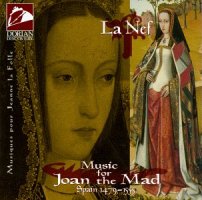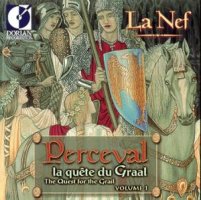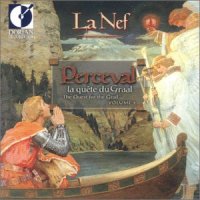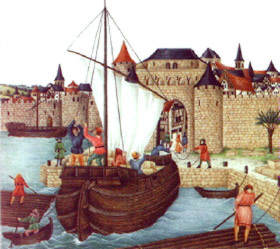


After having distributed all they possessed to those who had defended them for ten months, the "Perfects" of Montségur threw themselves together into the bonfire prepared by the Catholics at the foot of the mountain.
In all, two hundred and twenty men and women perished in the flames. Among them were soldiers of the garrison who, not wishing to abandon the people, sacrificed themselves. As the blaze quickly grew to a huge conflagration, the Veni Creator, sung by thousands of voices, drowned out the cries and moans of the victims. The terrestrial flames became one with those of Hell. -- 13th Cent chronicler



I first came across La Nef via an indirect route. A lovely friend Estie who shares my love of music introduced me to the Era trilogy by Eric Levi. This is based on the Cathars who were all slaughtered at Montsegur at the height of the Inquisition and the Crusades against heretics. Another friend, Roman (who also has excellent taste in music), using the Cathar/Montsegur connection, sent me Montségur: la tragédie cathare, and for good measure, their other albums too.
Eric Levi uses pseudo-Latin chants, mixed with rock, disco, dance and haunting guitar riffs. Without listening, it sounds as though it would be bloody awful, but it is not, and surprisingly works. He seems to be conjuring up the Cathar legend through music.
La Nef appear to be attempting the same thing. There are similarities with the Eric Levi trilogy (who came first, did they know of each other), but what I am more strongly reminded of is the beautiful music of Hildegard von Bingen (the main difference being the addition of male voices and instrumentation).
La Nef are an Early Music ensemble, but the difference between them and any of their contemporaries is that they are composing their own music, not performing period pieces. And yet the effect is dramatic. Strange, they get classified as World Music, New Age and Celtic. This may be the difficulty of classification, or those who have attempted to categorise are more familiar with the latter, but may also be because although their music lies predominately in the Middle Ages, it does have hints of New Age and Celtic woven into the fabric of the pieces. Hence the faint similarity with the Eric Levi trilogy.
 The ensemble La Nef was created spring 1991, all members have performed in various early music ensembles. The line up, five to eight players, drawn from a core of twenty performers of different musical backgrounds (early, classical and world music), changes from album to album, but includes: voice, percussion, oud, recorders, harp, transverse flute, psaltery, cornemuse (bagpipes), contralto, lute, reciter, gemshorn, bowed psaltery, viola de gamba, bowed vielle, santur. The ensemble was founded by Sylvain Bergeron, Claire Gignac and Viviane LeBlanc
The ensemble La Nef was created spring 1991, all members have performed in various early music ensembles. The line up, five to eight players, drawn from a core of twenty performers of different musical backgrounds (early, classical and world music), changes from album to album, but includes: voice, percussion, oud, recorders, harp, transverse flute, psaltery, cornemuse (bagpipes), contralto, lute, reciter, gemshorn, bowed psaltery, viola de gamba, bowed vielle, santur. The ensemble was founded by Sylvain Bergeron, Claire Gignac and Viviane LeBlanc
A venturesome world-faring vessel, La Nef is seeking, discovering, exploring, making its ports of call in distant times and ancient lands. It has gathered a faithful crew: jugglers, minstrels, actors and jesters. La Nef takes you on an adventure. In lieu of gold and weapons it carries songs. Sounds heard over seas of yore, words and melodies collected from foreign shores and forgotten ports.
La Nef is taken from the French word 'nef' (nave from the Latin navis, ship). A large wooden sailing ship that took the Crusaders to the Holy Lands and brought back looted gold for the Kings. Nave, in English, is that part of a church reserved for worship by the laity.
La Nef have released the following albums (all on Dorian):
All are based on events or tales from the Middle Ages.
Commentary on albums has unashamedly been lifted from elsewhere.
Montségur: la tragédie cathare
Montségur: la tragédie cathare, written and performed by the French Canadian early music ensemble La Nef, is based upon the massacre of the Cathars at Montsegur (16 March 1244).
The Cathars
The Cathars were a Catholic sect of the Middle Ages, judged and condemned as heretics, whose religion preached a life ideal based on asceticism and purity. The Greek word Cataros means ‘Pure’. They were severely persecuted by the clergy and the political powers who sought to annex the rich land of Oc to the crown, and were targeted by the Inquisition. Refusing to renounce their faith, independence, and way of life, the last Cathars perished in the flames of a bonfire at Montségur (16 March 1244). The capitulation of Montségur, the last Catharist fortress, put an end to this Crusade. With the annexation of Languedoc to the Kingdom of France, the art of the troubadours disappeared, where once it had flourished in this land of tolerance, freedom and Courts of Love.
The Music
There remain almost no extant documents penned by the Cathars. All seems to have been obliterated by the turmoil caused by the Crusade and the fury of the Inquisition. Similarly, no traces of musical practice survive.
The Cathars’ doctrine rests on the antagonism between Good and Evil. History retains a dualistic image with the People of the South on the one hand (Gentiles, Perfects or Bonhommes, as they were known), and the People of the North on the other (French Barons, Clergy). The musical selections, arrangements and interpretations, drawn from various sources, play on this notion of opposition.
On one hand, we have the softer side with quiet instruments (harps, lutes, flutes), female voices, and Troubadour poetry glorifying love, the highest human ideals, generosity, nobility of heart, while on the other we encounter the thunderous sound of bagpipes, shawms and percussion.
The Performers
Music for Joan the Mad - Spain 1479-1555
Joan the Mad
The daughter of King Ferdinand of Aragon and Queen Isabella of Castile and the mother of King Charles V, Joan the Mad (Juana la Loca en español) was a Spanish queen who lived from 1479-1555. She is believed to have suffered from mental illness - possibly schizophrenia - and as a result was confined to the historic castle at Tordesillas.
In the gloom of a stone castle, the recluse wanders in silence, a forgotten woman. She is Joan, Juana, who has been called La Loca (the mad).
A haunting melody breaks the silence. Was it a flute? a voice perhaps? The lament of a viol, a cascade of chords on the lute, some eerie bell sounds drift along the echoing halls. Behold: shadows arise out of the gloom. These are the musicians, come back to sing and play for her, the phantoms of a long lost happiness.
They bow and take their places. Joan commands them: Is she not the rightful queen of Spain, the daughter of the Catholic kings, of Ferdinand of Aragon and Isabella of Castile? Mother of Charles the Fifth, Holy Roman Emperor, master of the world? The musicians mock her, but they obey her orders for they are handsomely rewarded. By and by the mad queen joins them in singing and playing of instruments. The stone walls shake, the iron doors shudder and cast open. Gloom and tears fade away and the full sunlight of old Castile and Leon enters the castle of Tordesillas.
For a short while, Joan feeds on the music, for it is music that revives the dust-laden scenes entombed in her memory - the victory over the Moors, the exile of the Jews, the court of the Catholic Kings, the conquest of the New World - and her husband, Philip the Handsome, for whom her heart still longs.
Joan had two great loves and obsessions in her life: her husband and music. Often her only source of consolation, Joan surrounded herself with music and musicians both in Holland and in Spain. She commanded a reputable musical chapel composed of first rate singers (cantores), and instrumentalists (ministriles) who danced to her tune, until her father seized the regency and had her locked away in Tordesillas.
The Music
Music for Joan the Mad was inspired by the life of the Spanish queen, who was believed to be a major music lover. La Nef don't claim that Music for Joan the Mad is an exact reproduction of Spanish music from the 15th and 16th Centuries - the Quebec-based ensemble takes its share of liberties.
Spanish and French lyrics, elements of both European, Catholic and Middle Eastern music. Music for Joan the Mad consists of of what is known as "modal" or "scalar" playing—Arabic, Jewish, Armenian, Greek, Indian, Turkish and North African music are all modal-oriented, and in the 1960s, modality was embraced by such jazz innovators as John Coltrane, Miles Davis, Rahsaan Roland Kirk, Pharoah Sanders and Yusef Lateef. The period is a time when European folk music was greatly influenced by Jews and Arabs, both of whom were violently forced out of Spain in the name of Christianity.
Perceval, la Quete du Graal
Perceval, la Quete du Graal is available as two CDs, Vol I and Vol II, ie not as a double CD.
Perceval or The Story of the Grail
Around 1180, Chrétien de Troyes began his last novel, Perceval or The Story of the Grail. He died before finishing it, leaving an enigma which still fascinates medieval scolars and historians today.
The Grail is one of the most important myths in Western culture. As both symbol and object, the Grail has captured people’s imagination for centuries. It starts in the Middle Ages with the poets Chrétien de Troyes, Robert de Boron and Wolfram von Escenbach whose texts are linked to the Arthurian cycle as a whole. These narratives are inspired by Celtic, Breton and Welsh legends.
The Grail takes on a multitude of forms, depending on which text is consulted. It is varyingly the Vessel used by Jesus Christ at the Last Supper, the Cup in which Joseph of Arimethea collected the blood that flowed from Jesus’ side after Longinus pierced him, a lance, a stone, a treasure.
There is also a link with the Cathars at Montsegur. According to legend, Montsegur served an additional function as a refuge for the sacred treasure of the Grail, the safekeeping of which was allegedly part of the function of the Cathari. Following the sacking of Montsegur and the massacre of all those who held out in the seige, coins and sacred objects left behind by the Cathars were distributed to the conquerors, but according to Inquisition records, the real treasure vanished the night before the capitulation. Four Cathars and the Cathars' treasure were said to have been let down the steepest side of the mountain by ropes and disappeared.
The Music
In keeping with their creative mandate, La Nef offers their very own version of the story of the Grail, put to original music. This timeless collage borrows from various sources such as Medieval Play, Baroque Opera and also looks to contemporary performance practise.
Much of the musical material stems from folkloric music of the British Isles. These melodies of flowing, pure lines and Celtic flavours, refer back to the places of origin of the Grail: Wales, Cornwall, Brittany and Scotland. The title role is sung by a Countertenor, a voice type which faithfully renders Young Perceval’s innocence, whereas the instruments (harp, vielle, early guitar, traditional flutes) add a typical timber to the voices.
Recorded at L'Eglise de la Nativité de la Sainte-Vierge, Québec (November 1998).
The Players